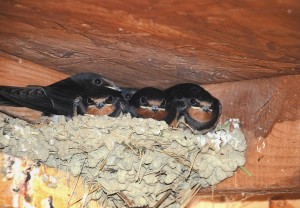 Swallows need insects as their basic food and this poses problems early in the summer. So to start with they will assemble in scattered flocks to hunt over areas such as Loch Flemington to the east of Inverness. Then there are very few places where there is an abundance of the swallows’ main food, insects. Lochs and to a lesser extent slow moving rivers are good early feeding sites for the birds particularly as they feed almost exclusively on flying insects. They have been recorded snapping insects off trees and even caterpillars but it is the flying insects that their acrobatic flight is geared to exploit. They are also adept at taking insects from the surface of the water which looks quite dramatic. A wide range of insects are taken but early in the season it is mainly flies. Later other insects include flying ants, bees, wasps, moths, mayflies and sawflies. Swallows are adept at taking insects that are disturbed by stock such as sheep and cattle and they will even swoop around people who are out walking. If it is a good summer for insects then the swallows may have two broods and even three if there is an abundance of food.
Swallows need insects as their basic food and this poses problems early in the summer. So to start with they will assemble in scattered flocks to hunt over areas such as Loch Flemington to the east of Inverness. Then there are very few places where there is an abundance of the swallows’ main food, insects. Lochs and to a lesser extent slow moving rivers are good early feeding sites for the birds particularly as they feed almost exclusively on flying insects. They have been recorded snapping insects off trees and even caterpillars but it is the flying insects that their acrobatic flight is geared to exploit. They are also adept at taking insects from the surface of the water which looks quite dramatic. A wide range of insects are taken but early in the season it is mainly flies. Later other insects include flying ants, bees, wasps, moths, mayflies and sawflies. Swallows are adept at taking insects that are disturbed by stock such as sheep and cattle and they will even swoop around people who are out walking. If it is a good summer for insects then the swallows may have two broods and even three if there is an abundance of food.
The birds are absent from some of the upland areas such as mountain ranges and the flow country. They are scattered throughout the Highlands but there are two core areas where the largest numbers of breeding pairs are found. One is around Inverness and just north up the east coast and the other area is the north eastern half of Caithness. They also occur in small numbers in the Western and Northern Isles. Most swallows build their nests in buildings as opposed to under eaves like house martins do. There are occasional records of them breeding under eaves but it is unusual. They will take to artificial nests which may help the birds as building nests is time and energy consuming. Previously used nests are often re-used. A few cliff nesting sites were recorded in the Highlands in the 19th century but none in recent years. One unusual site has been the swing bridge over the canal at Fort Augustus where several pairs have bred. Ringing has shown that most adult swallows come back to the same breeding site, sometimes even the same nest but young birds tend to wander.
The first sign that the birds are back at their breeding site is a male sat nearby often on overhead wires as it waits for a female to fly in to the site. The long tail feathers of the male are conspicuous and even more so when he is joined by a female and her tail is significantly shorter. Later in the year when the family parties gather it is easy to identify the male, female and juveniles by the difference in the lengths of their respective tail feathers. The nest is built by both the male and female but only the female incubates the eggs. Numbers of breeding pairs vary from year to year often associated with weather in or to and from their African winter quarters. Over the last ten years studies have indicated an over all increase of 22% in Britain but in Scotland, for some unknown reason, this has been much lower only 3% in terms of numbers. The large autumn roosts of swallows have attracted members of the Highland Ringing Group and the last figures, for 2008, indicated 1,845 birds were ringed and of these 648 were nestlings. Ringing has shown that young swallows, such as the one in the photograph, disperse widely in all directions throughout Northern Scotland, before heading south on migration.
